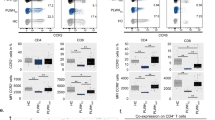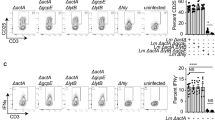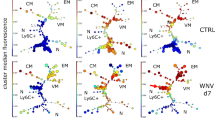Abstract
Viral replication and microbial translocation from the gut to the blood during HIV infection lead to hyperimmune activation, which contributes to the decline in CD4+ T cell numbers during HIV infection. Programmed death-1 (PD-1) and interleukin-10 (IL-10) are both upregulated during HIV infection. Blocking interactions between PD-1 and programmed death ligand-1 (PD-L1) and between IL-10 and IL-10 receptor (IL-10R) results in viral clearance and improves T cell function in animal models of chronic viral infections. Here we show that high amounts of microbial products and inflammatory cytokines in the plasma of HIV-infected subjects lead to upregulation of PD-1 expression on monocytes that correlates with high plasma concentrations of IL-10. Triggering of PD-1 expressed on monocytes by PD-L1 expressed on various cell types induced IL-10 production and led to reversible CD4+ T cell dysfunction. We describe a new function for PD-1 whereby microbial products inhibit T cell expansion and function by upregulating PD-1 levels and IL-10 production by monocytes after binding of PD-1 by PD-L1.
This is a preview of subscription content, access via your institution
Access options
Subscribe to this journal
Receive 12 print issues and online access
$209.00 per year
only $17.42 per issue
Buy this article
- Purchase on Springer Link
- Instant access to full article PDF
Prices may be subject to local taxes which are calculated during checkout






Similar content being viewed by others
References
El-Far, M. et al. T-cell exhaustion in HIV infection. Curr. HIV/AIDS Rep. 5, 13–19 (2008).
Klenerman, P. & Hill, A. T cells and viral persistence: lessons from diverse infections. Nat. Immunol. 6, 873–879 (2005).
Brenchley, J.M. et al. Microbial translocation is a cause of systemic immune activation in chronic HIV infection. Nat. Med. 12, 1365–1371 (2006).
Breen, E.C. et al. Infection with HIV is associated with elevated IL-6 levels and production. J. Immunol. 144, 480–484 (1990).
Chollet-Martin, S. et al. Comparison of plasma cytokine levels in African patients with HIV-1 and HIV-2 infection. AIDS 8, 879–884 (1994).
Ketlinskii, S.A. et al. Tumor necrosis factor-α and interleukin-1β in the blood plasma of patients with HIV infection. Vestn. Ross. Akad. Med. Nauk. 9–10, 36–41 (1992).
Norris, P.J. et al. Elevations in IL-10, TNF-α, and IFN-γ from the earliest point of HIV Type 1 infection. AIDS Res. Hum. Retroviruses 22, 757–762 (2006).
Salazar-Gonzalez, J.F. et al. Relationship of plasma HIV-RNA levels and levels of TNF-α and immune activation products in HIV infection. Clin. Immunol. Immunopathol. 84, 36–45 (1997).
Than, S. et al. Cytokine pattern in relation to disease progression in human immunodeficiency virus–infected children. J. Infect. Dis. 175, 47–56 (1997).
Barber, D.L. et al. Restoring function in exhausted CD8+ T cells during chronic viral infection. Nature 439, 682–687 (2006).
Day, C.L. et al. PD-1 expression on HIV-specific T cells is associated with T cell exhaustion and disease progression. Nature 443, 350–354 (2006).
Trautmann, L. et al. Upregulation of PD-1 expression on HIV-specific CD8+ T cells leads to reversible immune dysfunction. Nat. Med. 12, 1198–1202 (2006).
Petrovas, C. et al. PD-1 is a regulator of virus-specific CD8+ T cell survival in HIV infection. J. Exp. Med. 203, 2281–2292 (2006).
Velu, V. et al. Enhancing SIV-specific immunity in vivo by PD-1.blockade. Nature 458, 206–210 (2009).
Brooks, D.G. et al. Interleukin-10 determines viral clearance or persistence in vivo. Nat. Med. 12, 1301–1309 (2006).
Ejrnaes, M. et al. Resolution of a chronic viral infection after interleukin-10 receptor blockade. J. Exp. Med. 203, 2461–2472 (2006).
Clerici, M. et al. Human immunodeficiency virus (HIV) phenotype and interleukin-2/ interleukin-10 ratio are associated markers of protection and progression in HIV infection. Blood 88, 574–579 (1996).
Stylianou, E., Aukrust, P., Kvale, D., Muller, F. & Froland, S.S. IL-10 in HIV infection: increasing serum IL-10 levels with disease progression–down-regulatory effect of potent anti-retroviral therapy. Clin. Exp. Immunol. 116, 115–120 (1999).
Orsilles, M.A., Pieri, E., Cooke, P. & Caula, C. IL-2 and IL-10 serum levels in HIV-1–infected patients with or without active antiretroviral therapy. APMIS 114, 55–60 (2006).
Clerici, M. et al. Role of interleukin-10 in T helper cell dysfunction in asymptomatic individuals infected with the human immunodeficiency virus. J. Clin. Invest. 93, 768–775 (1994).
Hagiwara, E., Sacks, T., Leitman-Klinman, S.F. & Klinman, D.M. Effect of HIV infection on the frequency of cytokine-secreting cells in human peripheral blood. AIDS Res. Hum. Retroviruses 12, 127–133 (1996).
Kumar, A. et al. Differential production of IL-10 by T cells and monocytes of HIV-infected individuals: association of IL-10 production with CD28-mediated immune responsiveness. Clin. Exp. Immunol. 114, 78–86 (1998).
Gröschel, S. et al. TLR-mediated induction of negative regulatory ligands on dendritic cells. J. Mol. Med. 86, 443–455 (2008).
Meier, A. et al. Upregulation of PD-L1 on monocytes and dendritic cells by HIV-1 derived TLR ligands. AIDS 22, 655–658 (2008).
Keir, M.E., Butte, M.J., Freeman, G.J. & Sharpe, A.H. PD-1 and its ligands in tolerance and immunity. Annu. Rev. Immunol. 26, 677–704 (2008).
Lin, D.Y. et al. The PD-1/PD-L1 complex resembles the antigen-binding Fv domains of antibodies and T cell receptors. Proc. Natl. Acad. Sci. USA 105, 3011–3016 (2008).
Gordon, S. et al. Monocyte and macrophage heterogeneity. Nat. Rev. Immunol. 5, 953–964 (2005).
Heil, F. et al. Species-specific recognition of single-stranded RNA via Toll-like receptor 7 and 8. Science 303, 1526–1529 (2004).
Frankenberger, M., Sternsdorf, T., Pechumer, H., Pforte, A. & Ziegler-Heitbrock, H.W. Differential cytokine expression in human blood monocyte subpopulations: a polymerase chain reaction analysis. Blood 87, 373–377 (1996).
de Waal Malefyt, R. et al. Interleukin 10 (IL-10) and viral IL-10 strongly reduce antigen-specific human T cell proliferation by diminishing the antigen-presenting capacity of monocytes via downregulation of class II major histocompatibility complex expression. J. Exp. Med. 174, 915–924 (1991).
Younes, S.A. et al. HIV-1 viremia prevents the establishment of interleukin 2–producing HIV-specific memory CD4 T cells endowed with proliferative capacity. J. Exp. Med. 198, 1909–1922 (2003).
Niemand, C. et al. Activation of STAT3 by IL-6 and IL-10 in primary human macrophages is differentially modulated by suppressor of cytokine signaling 3. J. Immunol. 170, 3263–3272 (2003).
Trabattoni, D. et al. B7–H1 is up-regulated in HIV infection and is a novel surrogate marker of disease progression. Blood 101, 2514–2520 (2003).
Zhong, Z. et al. Stat3: a STAT family member activated by tyrosine phosphorylation in response to epidermal growth factor and interleukin-6. Science 264, 95–98 (1994).
Bright, J.J. et al. TGF-β inhibits IL-12–induced activation of Jak-STAT pathway in T lymphocytes. J. Immunol. 161, 1772–1777 (1998).
Huber, M. et al. IRF4 is essential for IL-21–mediated induction, amplification and stabilization of the TH17 phenotype. Proc. Natl. Acad. Sci. USA 105, 20846–20851 (2008).
El Kasmi, K.C. et al. General nature of the STAT3-activated anti-inflammatory response. J. Immunol. 177, 7880–7888 (2006).
Williams, L. et al. Signal transducer and activator of transcription 3 is the dominant mediator of the anti-inflammatory effects of IL-10 in human macrophages. J. Immunol. 172, 567–576 (2004).
Berlato, C. et al. Involvement of suppressor of cytokine signaling-3 as a mediator of the inhibitory effects of IL-10 on lipopolysaccharide-induced macrophage activation. J. Immunol. 168, 6404–6411 (2002).
Urbani, S. et al. PD-1 expression in acute hepatitis C virus (HCV) infection is associated with HCV-specific CD8 exhaustion. J. Virol. 80, 11398–11403 (2006).
Geng, L. et al. B7–H1 expression is upregulated in peripheral blood CD14+ monocytes of patients with chronic hepatitis B virus infection, which correlates with higher serum IL-10 levels. J. Viral Hepat. 13, 725–733 (2006).
Shrestha, S. et al. Interleukin-10 gene (IL-10) polymorphisms and human papillomavirus clearance among immunosuppressed adolescents. Cancer Epidemiol. Biomarkers Prev. 16, 1626–1632 (2007).
Swaminathan, S. Molecular biology of Epstein-Barr virus and Kaposi's sarcoma–associated herpesvirus. Semin. Hematol. 40, 107–115 (2003).
Accapezzato, D. et al. Hepatic expansion of a virus-specific regulatory CD8+ T cell population in chronic hepatitis C virus infection. J. Clin. Invest. 113, 963–972 (2004).
Yao, S. et al. PD-1 on dendritic cells impedes innate immunity against bacterial infection. Blood 113, 5811–5818 (2009).
Boasso, A. et al. PDL-1 upregulation on monocytes and T cells by HIV via type I interferon: restricted expression of type I interferon receptor by CCR5-expressing leukocytes. Clin. Immunol. 129, 132–144 (2008).
Pandrea, I. et al. Paucity of CD4+CCR5+ T cells is a typical feature of natural SIV hosts. Blood 109, 1069–1076 (2007).
Huang, X. et al. PD-1 expression by macrophages plays a pathologic role in altering microbial clearance and the innate inflammatory response to sepsis. Proc. Natl. Acad. Sci. USA 106, 6303–6308 (2009).
Nelson, D.R. et al. Long-term interleukin 10 therapy in chronic hepatitis C patients has a proviral and anti-inflammatory effect. Hepatology 38, 859–868 (2003).
Xiao, Y. et al. Cell-surface processing of extracellular human immunodeficiency virus type 1 Vpr by proprotein convertases. Virology 372, 384–397 (2008).
Acknowledgements
We thank the subjects for their participation in this study. We also thank M. Legault and C. Grignon for their clinical assistance with the recruitment of study subjects. We are grateful to V.A. Evans and J.D. Schatzle for help in manuscript revision. E.A.S., L.T., M.E.-F. and J.V.G. are funded by the Canadian Institutes of Health Research (CIHR). N.H.S. holds a joint New Investigator Award from the Canadian Foundation for Infectious Diseases and CIHR. J.B. and J.-P.R. are clinician-scientists supported by Fonds de la recherche en santé du Québec. R.-P.S. is the Canada Research Chair in Human Immunology. This study was supported by funds from the US National Institutes of Health, the CIHR, the Canadian Foundation for AIDS Research, the Fonds de la recherche en santé du Québec AIDS and Infectious Disease Network (SIDA-MI) and the Canadian Network for Vaccines and Immunotherapeutics. This study was funded in part by the Intramural Program of the US National Institutes of Health. Vectors were generously provided by E. Cohen at the Institut de Recherches Cliniques de Montréal. The lentiviral vector pWPI (empty vector), packaging plasmid psPAX2 and envelope plasmid pMD2G were generously provided by D. Trono (University of Geneva).
Author information
Authors and Affiliations
Contributions
E.A.S. conducted all experiments and wrote the manuscript. F.P.D. participated in performing and planning the experiments in Figure 1b,c and Supplementary Figures 2 and 6a,c–e. L.T. participated in performing and planning the experiments in Figures 1, 3a,d, 4a,c and 5a. Y.Z. prepared the vectors used for the transduction of Cos cells and participated in the experiments in Figures 3i, 5b, 6e and Supplementary Figure 3a. Y.S. participated in the experiments in Figures 6a–c and Supplementary Figure 5d. M.E.-F. participated in the experiments in Figure 5c and Supplementary Figure 5. B.J.H. measured 16S DNA and soluble CD14 levels. A.N. participated in the experiments in Figure 5c. P.A. participated in the experiments in Figure 3. Y.P. participated in the experiments in Figure 6e and Supplementary Figure 6b,c,e. S.G.F. participated in the experiments in Figure 6e and Supplementary Figure 6b,c. J.V.G. participated in the experiments in Figure 1a,b. M.R.B., J.B., N.H.S. and J.-P.R. provided donor samples and data about the viral load and cell counts. D.C.D. performed 16S and soluble CD14 measurement and participated in the manuscript writing. E.K.H. participated in experimental design and in the manuscript writing. R.-P.S. supervised the project.
Corresponding author
Ethics declarations
Competing interests
The authors declare no competing financial interests.
Supplementary information
Supplementary Text and Figures
Supplementary Figures 1–8 (PDF 3085 kb)
Rights and permissions
About this article
Cite this article
Said, E., Dupuy, F., Trautmann, L. et al. Programmed death-1–induced interleukin-10 production by monocytes impairs CD4+ T cell activation during HIV infection. Nat Med 16, 452–459 (2010). https://doi.org/10.1038/nm.2106
Received:
Accepted:
Published:
Issue Date:
DOI: https://doi.org/10.1038/nm.2106
This article is cited by
-
Chronic non-bacterial osteomyelitis and immune checkpoint molecules
Clinical Rheumatology (2024)
-
The effect of PD-1/PD-L1 signaling axis on the interaction between CD19+B cells and CD4+T cells in peripheral blood of patients with systemic lupus erythematosus
Advances in Rheumatology (2023)
-
Chronic LCMV infection regulates the effector T cell response by inducing the generation of less immunogenic dendritic cells
Experimental & Molecular Medicine (2023)
-
PD-1 receptor outside the main paradigm: tumour-intrinsic role and clinical implications for checkpoint blockade
British Journal of Cancer (2023)
-
Potential Therapeutic Effects of Human Amniotic Epithelial Cells on Gynecological Disorders Leading to Infertility or Abortion
Stem Cell Reviews and Reports (2023)



